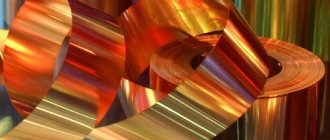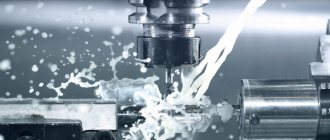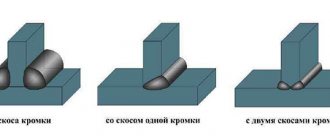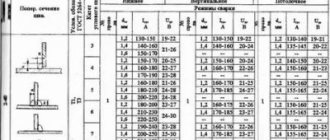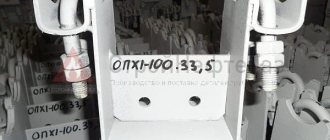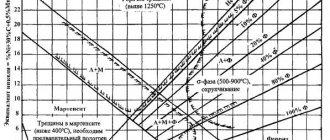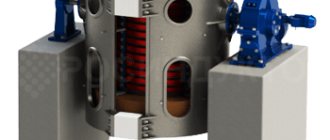In this article:
1. Furnaces for firing raw materials and intermediate products
2. Furnaces for smelting ores, concentrates and intermediates, as well as for refining metals
3. Furnaces for heating and heat treatment of non-ferrous metals
4. Furnaces for preparing and melting cast alloys
Non-ferrous metallurgy furnaces can be classified according to the following criteria:
- By technological purpose: drying;
- roasting;
- smelting;
- refining, foundry, heating furnaces;
- furnaces for heat treatment.
- lump furnaces;
- furnaces in which heat is released directly into the mass of the heated material;
- with a vertical working space - shaft furnaces;
- intermittently operating furnaces;
- recuperative and regenerative furnaces;
Furnaces for firing raw materials and intermediate products
A multi-hearth furnace is a vertical cylinder with a diameter of 4-8 m and a height of 4-12 m, divided in height by horizontal hearths. The initial charge is loaded onto the upper hearth and is sequentially moved from the hearth to the under by a rake device consisting of a central shaft and handles with paddles. Fuel and air are supplied to the furnace through windows on each hearth.
A drum rotary kiln has the shape of a horizontal cylinder with a diameter of 2-5 m and a length of 20-150 m. The charge and fuel usually enter the kiln from opposite ends of the kiln. The movement of the charge occurs due to rotation and some tilt of the furnace itself.
The sintering machine consists of a continuously moving chain of steel grates 1-4 m wide and 10-50 m long. The charge is poured in a layer on the surface of the grates and ignited in the head of the machine, and the air required for firing is sucked through the layer of material on the grates.
A furnace for firing in a fluidized bed is represented by a chamber with a transverse dimension of 2-8 m and a height of 3-15 m. Air entering the furnace through a hearth with a large number of holes maintains the processed material in a state of continuous movement, reminiscent of boiling liquid.
DIY FRIEND
Dear visitors to the “ Samodelkin Friend ” website, from the material provided you will learn how to make a melting furnace for melting aluminum and other fusible metals with your own hands. To melt low-melting metals such as aluminum, tin, brass, lead, copper, it is quite possible to make a homemade furnace or forge . The best fuel for such a furnace is liquefied propane gas, which is capable of raising the temperature inside the fire chamber to more than 1000° in a short period of time, and this is more than enough to melt aluminum scrap and melt it into blanks, for example, you can make pulleys, rollers, and much more what else)
This furnace is made of several parts - it is a metal body with a lid that has a hole for placing scrap in the crucible, inside there are 2 layers of insulation, the first is mineral wool and the second is a ceramic blanket (withstands high temperatures). Inside this chamber there is a crucible in which the metal is melted. A hole is made in the side part and a pipe with 4 fastening elements is welded in; it is necessary for fixing the gas burner nozzle during operation of the furnace. The crucible in such a furnace is located exactly in the center, the molten metal is removed from it using a special scoop and poured into pre-prepared molds.
So, let's look at the oven assembly process in more detail.
Materials
- professional pipe square
- sheet metal 1.5 mm
- crucible
- gas burner with propane cylinder
- mineral wool
- ceramic blanket
- wheels 4 pcs
Tools
- welding inverter
- Angle grinder (grinder)
- drilling machine
- pipe bender
- measuring tool
Step-by-step instructions for creating a melting furnace with your own hands.
Using a pipe bender, 4 rings of square-section professional pipe were bent.
Then the metal base of the oven itself with a lid is made directly.
Melting furnace lid.
There is such a neck, through it it will be possible to place scrap metal directly into the crucible.
The oven body inside has 2 layers of insulation - mineral wool and a ceramic blanket.
At the bottom of the furnace there is a welded pipe with a fastening; it is necessary to fix the gas burner nozzle during operation of the melting furnace.
Temperature measurement.
Molten metal.
Filling a sand mold with aluminum.
These are the blanks we got)
The homemade melting furnace was additionally equipped with a frame with 4 wheels, which allows it to be transported around the garage or workshop. Additionally, an electronic thermometer is installed to determine the temperature inside the oven.
Detailed video instructions from the author; here all the main points are covered more subtly from the very beginning to the smelting of the products. Enjoy watching.
- Tweet
- 6
Shared
Furnaces for smelting ores, concentrates and intermediates, as well as for refining metals
The reverberatory furnace has the shape of a horizontal chamber 4–10 m wide, 10–35 m long and 2–4 m high. The initial charge is loaded into the furnace through holes in the roof or through windows in the side walls, and the liquid smelting products accumulate in the furnace bath. Fuel is supplied from the head, and combustion products are discharged at the end of the furnace. Liquid smelting products, as they accumulate, are released from the furnace through special openings located at the bath level.
The shaft furnace consists of a vertical shaft 1-2 m wide, 5-15 m long and 5-8 m high, assembled from water-cooled boxes (caissons). Lump mixture and fuel are loaded from above, and air is supplied through tuyere holes located in the lower part of the furnace. The smelting products are continuously discharged into settling tanks or front furnaces.
An electric furnace for smelting ores and semi-products has a working space shape similar to a reverberatory furnace with slightly smaller dimensions. 3-6 carbon electrodes with a diameter of 0.6-1.4 m pass through the roof, through which electricity is supplied to the working space of the furnace. Loading the charge and releasing smelting products is also similar to a reverberatory furnace.
The converter is a horizontal cylinder with a diameter of 2-4 m and a length of 4-10 m, rotating around a horizontal axis.
Liquid matte and fluxes are loaded into the converter through the neck, and air is supplied through tuyeres directly into the bath.
Induction oven
The most popular furnaces for melting metals in small industries are induction melting furnaces.
These furnaces are used for melting materials such as
- steel,
- cast iron,
- stainless steel
The advantage of this type of furnace is that, working on inductors, they have the ability to pour liquid metal into a special ladle container. This occurs through the operation of a hydraulic system or a mechanical system.
Furnace devices:
- asbestos cement body;
- inductor (coil with many turns);
- a unit for melting with a crucible of thick building material (when choosing a furnace, you should take into account the size of the crucible, since the final amount of product obtained in one melting cycle will depend on this);
- busbars;
- batteries of compensating capacitors;
- water-cooled gearbox coils.
Induction oven
Through the emergence of vortex-type flows, the metal is heated and melted, which is placed in a special crucible made of graphite. The entire melting process and mixing of the metal mass takes place in this crucible, which occurs under the influence of electrodynamic forces. Electrical energy is supplied to the inductor installation through special two cables, which are used as water cooling. The entire structure is powered through the operation of a special device, such as a frequency converter.
Melting process in an induction furnace
A furnace for melting metals can be controlled in two ways:
- mechanically,
- via remote control.
Induction foundry furnaces are quite productive and high-quality equipment that is capable of producing large volumes of finished products.
There are various modifications of these furnaces that are suitable for any production facility specializing in the smelting of various types of metals. Popular types of electrical appliances include muffle melting furnace, steel melting furnace and arc steel melting furnace. The former are very effective and safe to use. The invention of the steel-smelting furnace played a very important role in metallurgy. With its help, it became possible to heat any materials.
In induction furnaces the smelting of steel such as
- brass,
- cast iron,
- copper,
- become,
- palladium,
- titanium,
- bronze,
- silver
- silumin.
Induction crucible furnaces can be distinguished into a special group. They allow you to load a large amount of materials (up to two or more tons). In Russia there are quite a lot of manufacturing plants of induction crucible furnaces. The quality of their products is always very high. It is important to remember that it is recommended to purchase induction crucible furnaces directly from the manufacturer.
The advantage of using induction furnaces is that this type of metal melting is economical. Heating the metal results in the release of a large amount of heat, which allows the furnace to heat up faster. As a rule, ovens with the ability to heat up to an average temperature of one thousand two hundred degrees are widespread. As a rule, the price of an induction melting furnace is quite high, since their production is labor-intensive, but these devices justify this cost with a long service life.
Furnaces for heating and heat treatment of non-ferrous metals
A methodical oven usually has a rectangular working space, elongated horizontally. The heated products are continuously moved by mechanical pushers from the loading end of the furnace to the unloading end of the heated products. The temperature of the methodical furnace along its length is not the same and has a maximum value on the side of product unloading. Fuel is supplied to the methodical furnace from the product unloading side, and exhaust gases are discharged through holes in the hearth into air heaters.
A chamber furnace differs from a methodical furnace in its slightly smaller size and frequency of operation, since the heated products lie motionless on the hearth from the beginning to the end of heating, after which the entire furnace charge is changed. The temperature throughout the working space of the chamber furnace is the same. Heating and thermal furnaces for non-ferrous metals and alloys in many cases operate on electric heating.
Melting metal and cast iron
A furnace for melting metal is a body made of fireclay bricks. The binding element is clay. The firebox is designed to burn coal. There is a hole at the bottom through which the air is blown into the inferno. At the bottom there is a cast iron grate called a grate. Coke or coal is laid out on it. It can be removed from the old stove. Sometimes refractory bricks are laid on edge when forming the body. The finished structure is fastened from the outside with a metal belt.
A furnace for melting metals must have a crucible. It can be an enameled or cast iron cauldron. The location of the crucible is next to the burning coke. To improve airflow, a fan is installed nearby. The equipment is used for steel smelting, but can be used as a furnace for cast iron smelting.
Furnaces for preparing and melting cast alloys
An induction furnace consists of a refractory crucible that holds from 1 to 30 tons of melt. Metals loaded into the furnace are heated and melted due to the heat generated in the metal itself during the conversion of electrical energy induced by a special winding (inductor) surrounding the crucible from the outside.
A vacuum arc furnace consists of a water-cooled crucible (crystallizer) made of an alloy of the same composition as that melted in the furnace, or of copper. The crystallizer is sealed and connected to a chamber under vacuum, which ensures high quality of the alloys produced in the furnace. Alloys are obtained by melting a consumable electrode under the action of an electric arc.
Industrial ovens
There are a large number of design options for metallurgical industrial furnaces. You can always make a choice depending on your specific needs and scale of production.
Classification of furnaces
Industrial furnaces can be classified according to the following main characteristics:
- the type of fuel used to operate the stove;
- the process that accompanies the melting of metal;
- method of heat release;
- design features of the furnace and other characteristics.
Metal casting.
Types of industrial furnaces
Depending on the source of thermal energy, there is the following division of furnaces:
- fiery. The energy in them comes from burning fuel. Depending on its type, stoves are divided into types: solid fuel;
- gas;
- liquid fuel;
- resistance furnaces. Electrical energy is converted into thermal energy when current flows through a conductor directly connected to an electrical circuit;
This is interesting: Machine for making baskets and rings BlackSmith TR3-25
Induction melting furnaces for melting gold and silver.
Types of industrial furnaces and their applications
According to technological purpose, industrial furnaces are divided into the following types:
- smelting: blast furnace. Large vertical shaft-type melting furnace. It produces cast iron and ferroalloys. A feature of the blast furnace process is its continuity throughout the entire life of the furnace: from its commissioning to “overhaul” repairs;
- open hearth. A furnace for processing scrap and pig iron into steel of a given quality and chemical composition. The operating principle is based on blowing a hot mixture of flammable gas and air into the furnace. This mixture is preheated in a regenerator;
- for non-ferrous metals. Furnaces of different types are used: flame and electric. They can be divided into five groups:
- crucible;
- arc;
- induction;
- furnaces for vacuum melting.
electrical reflective and flame;
The choice of equipment depends on the following factors:
- conditions and scale of production;
- purpose of cast parts;
- the range of alloys used and the energy capabilities of the production site.
- hardening Necessary to increase the mechanical strength of the metal;
metal normalization. Steel, cast iron and other metals are subjected to this treatment;
Medium frequency induction furnace for melting ferrous and non-ferrous metals.
Where can I buy
;
- Website: https://inductory.ru/;
- Address: 456300, Chelyabinsk region, Miass, post office box No. 22;
- Phone: 8-800-555-79-60;
The company sells transistor induction melting furnaces of the IPP series.
Muffle furnace
Muffle furnaces are often used for heat treatment of parts. Such equipment is characterized by a wide temperature range, from 20 to 1000 degrees.
A muffle furnace for hardening metal operates on different types of energy. However, at home it is better to use a unit that runs on electricity. Hardening is carried out in the furnace muffle.
A muffle furnace is made with your own hands in several stages:
- The muffle is made from fireclay bricks. Due to the round shape of the oven body, their corners are beveled. In each brick, grooves are selected where the spiral is laid.
- If the muffle furnace for melting is made from an oven, then the inside is lined with fire-resistant bricks. Grooves for the spiral are cut into the masonry.
- The chamber, made of refractory brick, is placed in a housing made of steel. Insulation is placed on the bottom. The gap between the side walls of the chamber and the housing is 4 cm, where the insulation is inserted. The top consists of 2 layers of metal and insulation.
- Holes are drilled in the housing, and the ends of the spiral are brought out through them, which are connected to the network cable.
- When using an oven, no insulation is required. It is already provided for in it.
Read also: How to get rid of superglue on your hands
